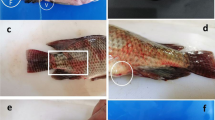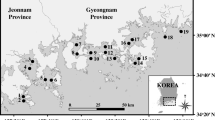Abstract
The occurrence of the hemolysin genes, tdh and trh, in Vibrio parahaemolyticus strains isolated from environmental samples collected from various exported seafood products comprising of fishes and shellfish (Mytilus edulis and Crassostrea gigas) or seawater, was studied. Eight strains were confirmed as V. parahaemolyticus by toxR -based polymerase chain reaction and only one strain out of these 8 strains was positive for tdh and trh genes. Toxigenic V. parahaemolyticus isolates are present in Tunisian coastal areas and they may also be present in Tunisian exported seafood products.


Similar content being viewed by others
References
Alcaide E, Amaro C, Todoli R, Oltra R (1999) Isolation and characterization of Vibrio parahaemolyticus causing infection in Iberian toothcarp Aphanius iberus. Dis Aquat Organ 35(1):77–80. doi:10.3354/dao035077
Alsina M, Blanch AR (1994) A set of keys for biochemical identification of environmental Vibrio species. J Appl Bacteriol 76(1):79–85
Bej AK, Patterson DP, Brasher CW, Vickery MC, Jones DD, Kaysner CA (1999) Detection of total and hemolysin-producing Vibrio parahaemolyticus in shellfish using multiplex PCR amplification of tl, tdh and trh. J Microbiol Methods 36(3):215–225
Christensen WB (1946) Urea decomposition as a means of differentiating Proteus and paracolon cultures from each other and from Salmonella and Shigella types. J Bacteriol 52(4):461–466
Croci L, Suffredini E, Cozzi L, Paniconi M, Ciccaglioni G, Colombo MM (2007a) Evaluation of different polymerase chain reaction methods for the identification of Vibrio parahaemolyticus strains isolated by cultural methods. J AOAC Int 90(6):1588–1597
Croci L, Suffredini E, Cozzi L, Toti L, Ottaviani D, Pruzzo C, Serratore P, Fischetti R, Goffredo E, Loffredo G, Mioni R (2007b) Comparison of different biochemical and molecular methods for the identification of Vibrio parahaemolyticus. J Appl Microbiol 102(1):229–237. doi:10.1111/j.1365-2672.2006.03046.x
DePaola A, Hopkins LH, Peeler JT, Wentz B, McPhearson RM (1990) Incidence of Vibrio parahaemolyticus in U.S. coastal waters and oysters. Appl Environ Microbiol 56(8):2299–2302
DePaola A, Nordstrom JL, Bowers JC, Wells JG, Cook DW (2003) Seasonal abundance of total and pathogenic Vibrio parahaemolyticus in Alabama oysters. Appl Environ Microbiol 69(3):1521–1526
Dileep V, Kumar HS, Kumar Y, Nishibuchi M, Karunasagar I (2003) Application of polymerase chain reaction for detection of Vibrio parahaemolyticus associated with tropical seafoods and coastal environment. Lett Appl Microbiol 36(6):423–427
FDA F, Drug Administration (1992) Bacteriological analytical manual, 2nd edn. Association of Official Analytical Chemists, Washington, DC
Hammack TS, Amaguana RM, Andrews WH (2001) An improved method for the recovery of Salmonella serovars from orange juice using universal preenrichment broth. J Food Prot 64(5):659–663
Hara-Kudo Y, Sugiyama K, Nishina T, Saitoh A, Nakagawa H, Ichihara T, Konuma H, Hasegawa J, Kumagai S (2001) Detection of TDH-producing Vibrio parahaemolyticus O3:K6 from naturally contaminated shellfish using an immunomagnetic separation method and chromogenic agar medium. Kansenshogaku Zasshi 75(11):955–960
Hervio-Heath D, Colwell RR, Derrien A, Robert-Pillot A, Fournier JM, Pommepuy M (2002) Occurrence of pathogenic vibrios in coastal areas of France. J Appl Microbiol 92(6):1123–1135
Hormansdorfer S, Wentges H, Neugebaur-Buchler K, Bauer J (2000) Isolation of Vibrio alginolyticus from seawater aquaria. Int J Hyg Environ Health 203(2):169–175
Ishihara M, Kawanishi A, Watanabe H, Tomochika K, Miyoshi S, Shinoda S (2002) Purification of a serine protease of Vibrio parahaemolyticus and its characterization. Microbiol Immunol 46(4):298–303
Kim YB, Okuda J, Matsumoto C, Takahashi N, Hashimoto S, Nishibuchi M (1999) Identification of Vibrio parahaemolyticus strains at the species level by PCR targeted to the toxR gene. J Clin Microbiol 37(4):1173–1177
Lee CY, Cheng MF, Yu MS, Pan MJ (2002) Purification and characterization of a putative virulence factor, serine protease, from Vibrio parahaemolyticus. FEMS Microbiol Lett 209(1):31–37
Lynch T, Livingstone S, Buenaventura E, Lutter E, Fedwick J, Buret AG, Graham D, DeVinney R (2005) Vibrio parahaemolyticus disruption of epithelial cell tight junctions occurs independently of toxin production. Infect Immun 73(3):1275–1283. doi:10.1128/IAI.73.3.1275-1283.2005
Nishibuchi M, Kaper JB (1995) Thermostable direct hemolysin gene of Vibrio parahaemolyticus: a virulence gene acquired by a marine bacterium. Infect Immun 63(6):2093–2099
O’Hara CM, Sowers EG, Bopp CA, Duda SB, Strockbine NA (2003) Accuracy of six commercially available systems for identification of members of the family vibrionaceae. J Clin Microbiol 41(12):5654–5659
Okuda J, Ishibashi M, Abbott SL, Janda JM, Nishibuchi M (1997) Analysis of the thermostable direct hemolysin (tdh) gene and the tdh-related hemolysin (trh) genes in urease-positive strains of Vibrio parahaemolyticus isolated on the West Coast of the United States. J Clin Microbiol 35(8):1965–1971
Ottaviani D, Bacchiocchi I, Masini L, Carraturo A, Russo GL, Giammarioli M, Sbaraglia G (2001) Correlation between medium acidification and pathogenicity in environmental halophilic non-cholera vibrios. Lett Appl Microbiol 33(1):61–64
Ottaviani D, Masini L, Bacchiocchi S (2003) A biochemical protocol for the isolation and identification of current species of Vibrio in seafood. J Appl Microbiol 95(6):1277–1284
Ottaviani D, Santarelli S, Bacchiocchi S, Masini L, Ghittino C, Bacchiocchi I (2005) Presence of pathogenic Vibrio parahaemolyticus strains in mussels from the Adriatic Sea, Italy. Food Microbiol 22:585–590
Ottaviani D, Leoni F, Serra R, Serracca L, Decastelli L, Rocchegiani E, Masini L, Canonico C, Talevi G, Carraturo A (2012) Nontoxigenic Vibrio parahaemolyticus strains causing acute gastroenteritis. J Clin Microbiol 50(12):4141–4143. doi:10.1128/JCM.01993-12
Potasman I, Paz A, Odeh M (2002) Infectious outbreaks associated with bivalve shellfish consumption: a worldwide perspective. Clin Infect Dis 35(8):921–928. doi:10.1086/342330
Quindos G, Salesa R, Carrillo-Munoz AJ, Lipperheide V, Jaudenes L, San Millan R, Torres-Rodriguez JM, Ponton J (1994) Multicenter evaluation of ATB fungus: a standardized micromethod for yeast susceptibility testing. Chemotherapy 40(4):245–251
Reed M, Muench H (1938) A simple method for estimating fifty per cent endpoints. Am J Hyg 27(493–497):493
Robert-Pillot A, Guenole A, Lesne J, Delesmont R, Fournier JM, Quilici ML (2004) Occurrence of the tdh and trh genes in Vibrio parahaemolyticus isolates from waters and raw shellfish collected in two French coastal areas and from seafood imported into France. Int J Food Microbiol 91(3):319–325
Tada J, Ohashi T, Nishimura N, Shirasaki Y, Ozaki H, Fukushima S, Takano J, Nishibuchi M, Takeda Y (1992) Detection of the thermostable direct hemolysin gene (tdh) and the thermostable direct hemolysin-related hemolysin gene (trh) of Vibrio parahaemolyticus by polymerase chain reaction. Mol Cell Probes 6(6):477–487
Wong SY, Leong TS (1990) A comparative study of Vibrio infections in healthy and diseased marine finfishes cultured in floating cages near Penang. Asian Fish Sci A3:353–359
Xu M, Yamamoto K, Honda T, Ming X (1994) Construction and characterization of an isogenic mutant of Vibrio parahaemolyticus having a deletion in the thermostable direct hemolysin-related hemolysin gene (trh). J Bacteriol 176(15):4757–4760
Yano Y, Kaneniwa M, Satomi M, Oikawa H, Chen SS (2006) Occurrence and density of Vibrio parahaemolyticus in live edible crustaceans from markets in China. J Food Prot 69(11):2742–2746
Zhang XH, Austin B (2005) Haemolysins in Vibrio species. J Appl Microbiol 98(5):1011–1019
Author information
Authors and Affiliations
Corresponding author
Rights and permissions
About this article
Cite this article
Khouadja, S., Suffredini, E., Spagnoletti, M. et al. Presence of pathogenic Vibrio Parahaemolyticus in waters and seafood from the Tunisian Sea. World J Microbiol Biotechnol 29, 1341–1348 (2013). https://doi.org/10.1007/s11274-013-1297-1
Received:
Accepted:
Published:
Issue Date:
DOI: https://doi.org/10.1007/s11274-013-1297-1




